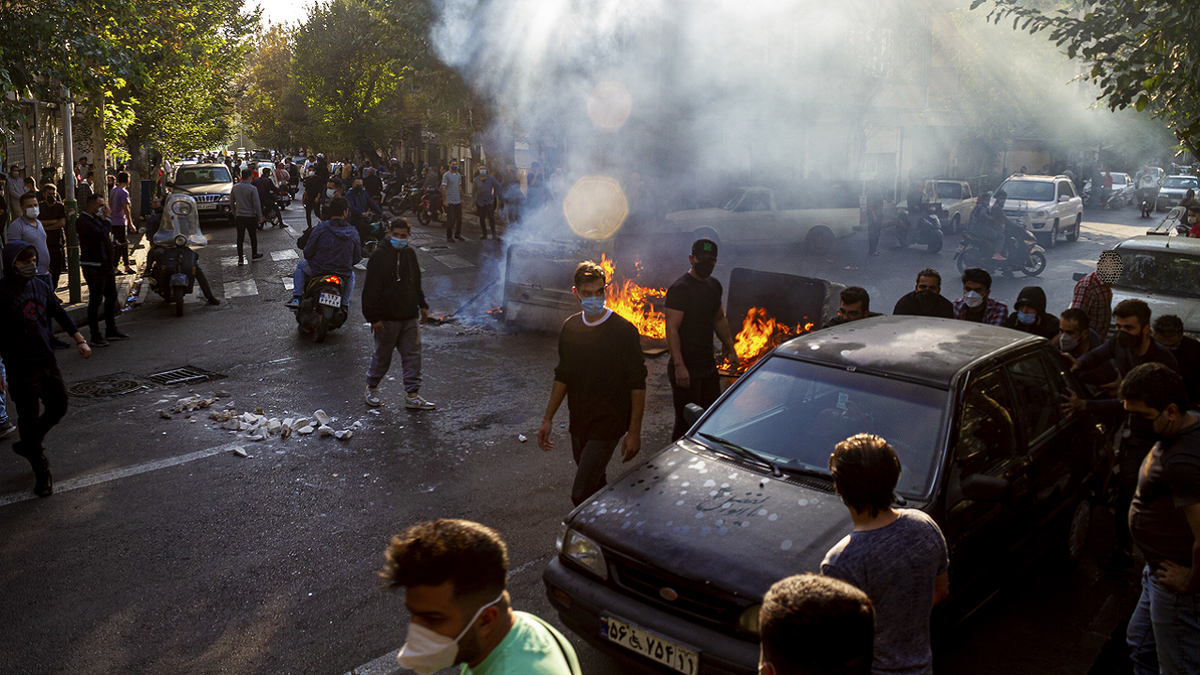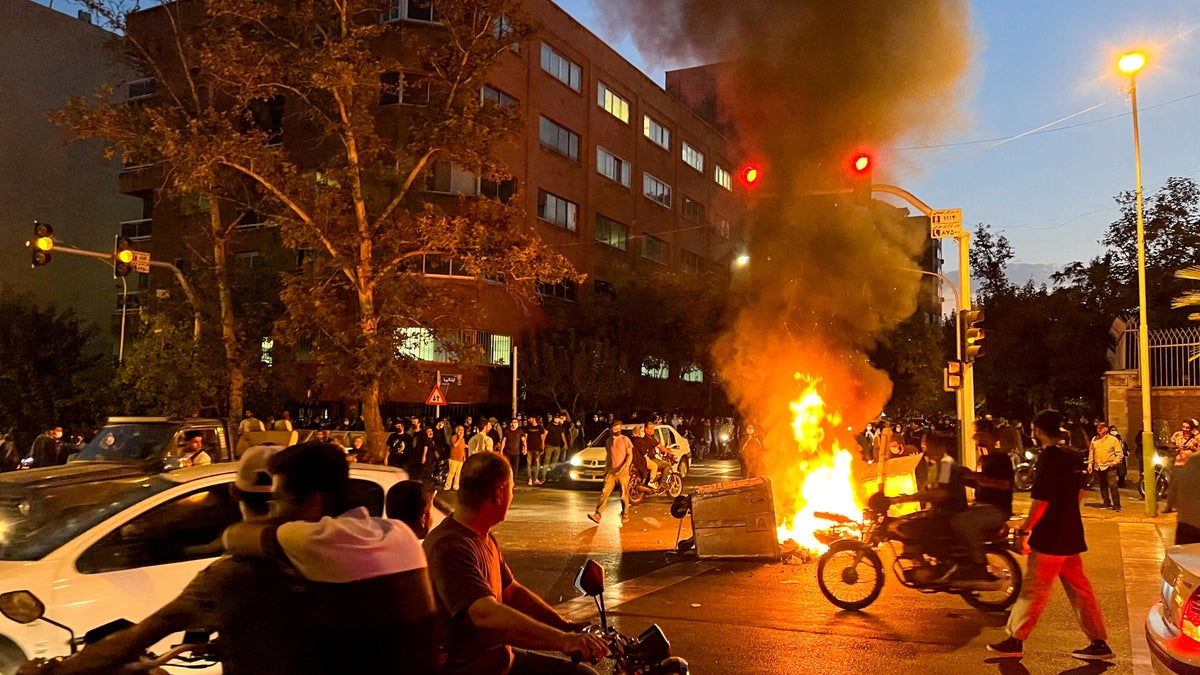Iranians continue to protest against country's regime for a 60th day
The United Nations has called a special session on Iran's human rights abuses for later this month. (Video credit: The Foreign Desk.)
Today marks the 60th day of continuous protests against the Iranian regime over the death of the 22-year-old woman Mahsa Amini while in the custody of the regime’s brutal morality police for not properly wearing a head covering.
The regime’s intense crackdown has killed at least 326 people, including 43 children, according to the Norway-based group Iran Human Rights.
After two months of alleged U.N. bureaucratic inertia, the body’s Human Rights Council is now being forced to respond to the bloodbath in Iran. The head of U.N. Watch, Hillel Neuer, wrote on Twitter: "For the first time in history the United Nations Human Rights Council will hold an emergency session on Iran. We are demanding the creation of an international Commission of Inquiry, a formal call to expel the Islamic Republic from the UN’s top women’s rights body."
The widespread security apparatus of Iran has arrested more than 14,000 people during the upheaval against the ayatollahs who run the country.

The grave of Mahsa Amini in her hometown of Saqqez, Iran. (Fox News Digital)
DISTURBING VIDEO SHOWS IRAN'S POLICE BRUTALLY BEATING ANTI-REGIME PROTESTER
Demonstrations and work stoppages unfolded over the last few days in several Iranian cities to remember the "Bloody Friday" massacre of almost 100 people in the southeastern city of Zahedan in response to the alleged murder of Amini and a reported rape of a 15-year-old girl by a police official.
Iran’s morality police arrested Amini on Sept.13 because she did not properly wear her hijab – a violation of the nation’s strict Islamic dress code that mandates women cover their hair. Amini died on Sept. 16.
Fox News Digital spoke with experts on Iran to gauge the potency of the protests that have blanketed the country since Amini's death in Tehran.
Iranian dissidents have termed the ongoing upheaval a nationwide uprising that is nothing short of a revolutionary movement.
"Based on the regular feedback I’ve been receiving from my compatriots in Iran, their protests are not stopping anytime soon but are only intensifying as each day goes by and as the Iranian regime continues to increase their beatings, arrests and killings of these protesters," Iran expert Karmel Melamed noted. "Politicians in America and Europe don’t seem to realize that these protesters are largely teenagers and young people under the age of 25 who have had enough of being ruled by this oppressive mullah regime anymore and are showing us every day in the streets of cities throughout Iran that nothing will stop them from their quest for real freedom."
STATE DEPARTMENT MADE 'CALCULATION' TO PRIORITIZE IRAN NUCLEAR DEAL OVER HUMAN RIGHTS ISSUES

Iranians protest the death of 22-year-old woman Mahsa Amini while in the custody of the country's morality police, in Tehran, Sept. 20, 2022. (AP Photo/Middle East Images, File)
The Washington, D.C.-based Institute for the Study of War said roughly 30 protests unfolded in 15 cities across 11 of Iran’s provinces in the first days of November.
Mahmood Amiry-Moghaddam, director of Iran Human Rights, said in a statement: "Iranians continue taking to the streets and are more determined than ever to bring fundamental changes. The response from the Islamic Republic is more violence. The international community must support the Iranian people’s right to self-determination and prevent further loss of lives by the Islamic Republic."
The pressing open question is, do Iranians have the staying power and sheer numbers on the streets to oust the regime? Erica Chenoweth, a Harvard University political scientist, posited the "3.5% rule" participation number for a protest movement to be in a position to topple a regime. Iran has a population of roughly 85 million, meaning nearly 3 million people would actively need to nonviolently participate in the mass movement.
It is unclear how Chenoweth’s theory would hold up against a violently totalitarian government like Iran's. In 2019, Iran’s rulers massacred at least 1,500 protesters during peaceful nationwide demonstrations against the regime.
IRAN PROTESTS TRIGGER SOLIDARITY RALLIES IN US, EUROPE

Iranians protest the death of Mahsa Amini after she was detained by the morality police, in Tehran, Oct. 27, 2022. (AP/Middle East Images, File)
The word "determination" unified the thoughts of many Iran analysts about the eight-week protest movement..
Alireza Nader, an Iran expert, said, "The determination of Iranian revolutionaries is impressive. They’ve refused to leave the streets after having been shot, arrested and tortured. In fact, more and more Iranians seem determined to overthrow the regime."
Nader took the White House to task for largely standing on the sidelines and issuing merely verbal support. "Yet the Biden administration has offered very little assistance beyond rhetoric," Nader said, adding a reference to Biden's special envoy for Iran, "U.S. policy will not change as long as Robert Malley remains in charge of Washington’s Iran policy,"
President Biden ostensibly took a more confrontational posture against the regime by recently declaring, "We’re going to free Iran."
However, John Kirby, strategic communications coordinator for Biden’s National Security Council, rapidly walked the president’s statement back, noting Biden was "expressing, again, our solidarity" with demonstrators in Iran.
IRAN DISMISSES PRESIDENT BIDEN AS 'TIRED,' CONDEMNS 'INTERFERENCE' IN PROTESTS
Lawdan Bazargan, who was imprisoned by Iran’s regime in Tehran’s notorious Evin prison in the 1980s for her political activities against the state, said, "This uprising of Iranian people is a full revolution targeting the pillars of the Islamic regime, in the name of social justice, wanting to create a new political institution. The slogan ‘Woman, Life, Liberty’ and the song ‘Barave’ contain all of their demands. The slogan and song cover topics such as freedom, gender equality, human rights, freedom of religion, justice, LGBTQ rights, refugee rights, and animal rights."
Hamid Charkhkar an Iranian American academic, said the regime is "desperate" and "running scared." He cited a personal example. Iran’s intelligence force "has actually questioned my brother about me and told him to ask me not to participate in protests in the U.S. and warned him that I will be interrogated should I decide to come back to Iran."
Charkhkar added, "After almost 60 days, we see that people still take it to streets on daily basis and they are determined to continue their fight against the regime. Youth in Iran are fed up and until they see a systemic change, they will not stop. As the regime increases its crackdown and does everything in its power to suppress protesters, Iranian youth find new ways to express their opposition to those in power."

A police motorcycle burns during a protest over the death of Mahsa Amini in Tehran, Iran, Sept. 19, 2022. (West Asia News Agency via Reuters//File Photo)
CLICK HERE TO GET THE FOX NEWS APP
He noted, "The latest example is knocking off mullahs’ turbans on streets. For a long time, the government has tried to create this image that Shia clergies, aka mullahs, are god’s representatives on Earth and they are holy. Now we see people making fun of them and breaking down their authority by such a simple act."
According to Charkhkar, "The scale of this uprising and its continuation are by far the largest compared to any other protests we have seen since the Islamic revolution in 1979."
Another Iranian American activist, Marjan Keypour Greenblatt, said, "The revolutionary uprising against the Iranian regime is evolving and entering a more serious phase. Iranian people and their rulers are fighting for the opposite objectives – the people want freedom and the regime insists on suppressing them, leaving no room for reconciliation and no possibility of retreat. This is a cause they’re willing to kill or die for. "




















